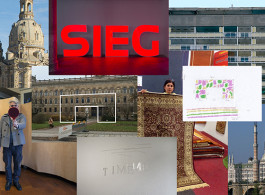Departing from the idea that every city has energies as well as neuralgic points that in synopsis make for the identity of its community the artists Florian Dombois, Nezaket Ekici, Via Lewandowsky and curator Thomas Eller have engaged in a months-long process working with the city of Dresden. Their discussions crystalized around three topics: “Historical consciousness” in Dresden, Dresden as Germany’s “capital for the natural sciences”, and (sadly) the city’s contested relation with “the others”.
Apparently Dresden derives a lot of its identity from Saxony’s history. The city’s art and cultural collections are legion. The wounds however that the 2nd World War and the subsequent division of Germany left, are still tangible and they are hurting. In this context the city’s relation to art and architecture from the GDR is still problematic. Which just means that the issue will have to be dealt with for quite some time longer.
Via Lewandowsky, based in Berlin, born in Dresden, puts his finger into this wound. His installation “Vergangenheit der Zukunft” – “Future’s past” reconstructs 4 letters of a socialist slogan previously attached to the top of a highrise building on Pirnaischer Platz. Instead of “DER SOZIALISMUS SIEGT” (Socialism is victorious), now only “S-I-E-G” (victory) is placed on scaffolding in front of the building. Many Dresdeners would like to attribute this sign to the performance of their local soccer team. However in the light of events in recent months and also beyond, the artwork is reminiscent of the fascist fallout of the GDR’s demise, which rears its ugly head more often than not.
Seemingly obscured from the general public a process takes place that has elevated Dresden to a top position as “City for the Sciences”, with more natural scientists per capita than any other German city. With a total of 45 research institutes and more than 4000 researchers, anything that will determine our future lives, from stem cell research to nuclear waste disposal sites, is being is being explored here.
Florian Dombois, an artist based in Bern, Switzerland, has extensively engaged with scientists in Dresden in processes of recursive time. His project “Inverse” calls into question ideas of progress in society, technology, as well as notions of avant-garde in the arts. – Was really everything better in the olden days?! – Or: Why is progress in society always a marker for the intellectual left? The self-consciously ephemeral project “Inverse” materializes in a “flock of happenings” on May 30th on Dresden’s Postplatz in which scientists from Dresden present for interlocution concrete examples from their research having to do with issues of “time and its direction”. This is preceded by a series of three evening talks in which the consequences of the scientific findings are being discussed. Maybe our notion of time as linear progress, that only distinguishes between “progressive” and “conservative” is too limited? – “What if time would run backwards?”
Another striking thing about Dresden is the apparent discrepancy between its traditional cosmopolitanism and the recent mega-demonstrations against an “islamization of the occident”. Visible witnesses to the latter is the Yenidze-building, a former tobacco factory built as orientalizing art-deco style architecture, or the Karl-May-Festspiele – a staged Cowboys and Indians festival in which German romanticism has degraded to folklore. The other side of the coin is the completely overblown fear by many demonstrators of being overrun by foreigners, when in fact there are only 4000 individuals of muslim denomination living in the entire state of Saxony. Dresden today has a hard time dealing with “the others”.
Berlin based artist Nezaket Ekici’s installation “Post It” in front of the state court building is an approximation to this topic. “Carpets”, as the artist has repeatedly pointed out in conversation, “are places for communication and communion – on carpets people meet and eat together. On carpets negotiations take place, differences are discussed and peace is made. The proximity to the court building hints to parallel practices of law and different notions of lawfulness that exist in different parts of German society. Her installation forms a portal made from carpets like the ones that can be found in many living rooms and hints towards the reception and integration of oriental cultural elements in German culture. Gottfried Semper – Dresden’s most influential architect in 1860 laid down his architecture theory as what was called “Bekleidungstheorie” “clothing theory”, seeing the origin of all architecture in nomadic use of fabrics and carpets as architecture. Yet another context to the work is being invoked by the installation’s title “Post It”. Most commonly yellow stickers are being used to note things one must not forget – the state court building is the site where on July 1, 2009 Marwa el Sherbini, a Egyptian pharmacist, was stabbed to death for xenophobic reasons.



